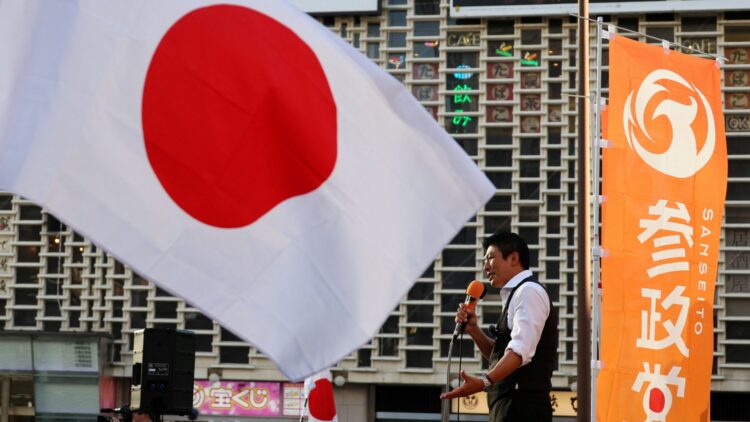In the most recent Japanese legislative elections, a once-fringe party gained ground on the political scene by capitalizing on popular dissatisfaction with the economy and globalization. Sanseito, which is known for its ultra-nationalist messages, stood out with emotional appeal and anti-immigration characteristics.
Sanseito’s electoral rise exposes dissatisfaction with the economy and globalism
The fringe far-right Sanseito party emerged as one of the biggest winners in Japan’s upper house election on Sunday, gaining support with warnings of a “silent invasion” of immigrants, and pledges for tax cuts and welfare spending. Birthed on YouTube during the COVID-19 pandemic spreading conspiracy theories about vaccinations and a cabal of global elites, the party broke into mainstream politics with its “Japanese First” campaign.
Public broadcaster NHK projected the party to win as many as 22 seats, adding to the single lawmaker it secured in the 248-seat chamber three years ago. It has only three seats in the more powerful lower house.Prime Minister Shigeru Ishiba’s Liberal Democratic Party and its coalition partner Komeito will likely lose their majority in the upper house, leaving them further beholden to opposition support following a lower house defeat in October.
“The phrase Japanese First was meant to express rebuilding Japanese people’s livelihoods by resisting globalism. I am not saying that we should completely ban foreigners or that every foreigner should get out of Japan,” Sohei Kamiya, the party’s 47-year-old leader, said in an interview with local broadcaster Nippon Television after the election.
In polling ahead of Sunday’s election, 29% of voters told NHK that social security and a declining birthrate were their biggest concern. A total of 28% said they worried about rising rice prices, which have doubled in the past year. Immigration was in joint fifth place with 7% of respondents pointing to it. “We were criticized as being xenophobic and discriminatory. The public came to understand that the media was wrong and Sanseito was right,” Kamiya said. Kamiya’s message grabbed voters frustrated with a weak economy and currency that has lured tourists in record numbers in recent years, further driving up prices that Japanese can ill afford, political analysts say.
Sanseito moderates discourse to broaden popular appeal
Sanseito’s good performance is due, in part, to its ability to modulate its discourse without abandoning its ideological pillars. The adoption of less aggressive language and the effort to include women among the candidates shows a clear intention to break the idea of being an exclusively male and radical party.
Kamiya, who won the party’s first seat in 2022 after gaining notoriety for appearing to call for Japan’s emperor to take concubines, has tried to tone down some controversial ideas formerly embraced by the party. During the campaign, Kamiya, however, faced a backlash for branding gender equality policies a mistake that encourage women to work and keep them from having children.
To soften what he said was his “hot-blooded” image and to broaden support beyond the men in their twenties and thirties that form the core of Sanseito’s support, Kamiya fielded a raft of female candidates on Sunday. Those included the single-named singer Saya, who clinched a seat in Tokyo.
However, the main elements of Japanese ultranationalism promoted by Sanseito remain. The defense of values considered “traditional,” opposition to multiculturalism, and the idea of a Japan surrounded by external threats remains as some of the main points of the party.
The impacts on the Japanese political landscape
Sanseito’s growth reveals not only dissatisfaction with the direction of the Japanese economy, but also a demand for more identitarian and nationalist discourses. By occupying this space, the party is challenging the traditional balance between moderation and pragmatism that characterized the country’s party system.
GCN.com/Reuters


